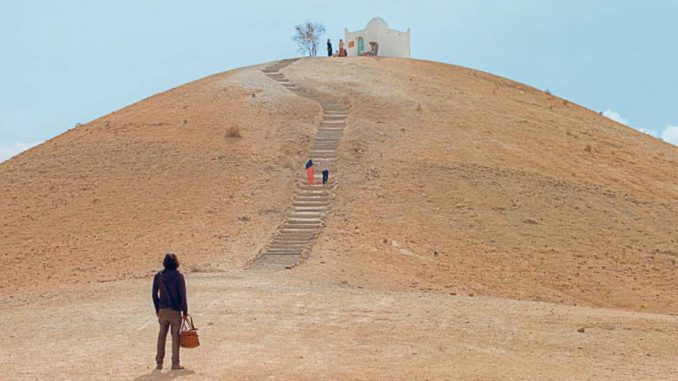
With this first feature film presented at Cannes, Alaa Eddine Aljem, a young filmmaker, has composed a comic work with an assertive style that takes a tender and humorous look at faith.
What is the purpose of erecting a place of worship? Involuntarily Amine, a thief, is at the origin of one of them. Fleeing into the desert with a breathless car, he got out of it with a bag full of banknotes, ran to the top of a nearby hill, dug a hole to bury a visibly ill-gotten loot and, to better find it, made it look like a grave. As soon as he got back to his car, he was stopped by the police. When he gets out of prison, Amine has only one obsession: to get the jackpot back. But on his return, he is surprised to discover that, on his false stele, a mausoleum to the Saint Unknown has been built and that at the foot of the hill a small community has been set up to welcome pilgrims.
Alaa Eddine Aljem’s first feature film is immediately set in a tender comical setting. With Amine, the viewer discovers a small world united by a belief born around his loot. The village has its figures defined by their function: the guardian of the mausoleum of the Saint Unknown who, supported by his beloved dog, will have to put off night after night Amine’s attempts to get back the money that everyone ignores, the hairdresser, barometer of the status of his clients, by the choice of shaving cream, the doctor, recently established, who resignedly learns the relative importance of his consultations and remedies, a father and son who cultivate a barren land by praying to the sky for rain that has been absent for decades.
The Miracle of the Holy Unknown stands on the thread of a humor that examines faith and a rural society without making fun of it. As in the world of Elia Suleiman, words are scarce, situations speak for themselves, poetry and smiles are born from the absurd.
A simple production favors long shots that underline the inspired frames and the unchanging nature of a time when almost identical scenes are repeated. The actors, professional or not, embody the emotions of their characters with looks and gestures, more than with their faces, which are willingly impassive. As a counterpart to its slowness and the invariants at the center of its comic springs, The Miracle of the Holy Unknown ends up suffering from a few lengths. But an appealing charm emerges from this first film, subtly charged with meaning.


Be the first to comment